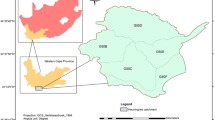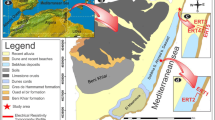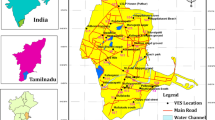Abstract
An electrical resistivity tomography survey has been conducted along the eastern coast of the Gulf of Aqaba in order to assess the salinity of the coastal shallow aquifer. The study area is extended from Ra’s Shikh Humayd to the town of Maqnah, northwest of Saudi Arabia. Eight electrical profiles were conducted using the Wenner–Schlumberger configuration. The total length of each profile was 360 m providing an expected maximum depth of penetration of about 50 m. All electrical profiles were conducted perpendicular to the coast and directed in the west–east direction. The inversion of the electrical data provided a clear two-dimensional image of the subsurface in the area that reflected the variations in the resistivity of the shallow aquifer system. The subsurface is composed of three layers: the upper layer corresponds to the dry alluvial and gravel deposits that have resistivity values in the range between 40 and 1400 Ω m. The second layer is the saturated zone of the alluvial sediments which represents the coastal aquifer in the study area. The resistivity value of the saturated zone is in the range of 0.15 to 25 Ω m. The lower layer in the subsurface stratification is the resistive bedrock which has resistivity values of more than 100 Ω m. It is composed of Pleistocene–Miocene sediments. The extension of saline water body has been mapped along all electrical profiles. The interpretation of the resistivity models shows that the salinity of the groundwater in the area is strongly related to three main factors: (1) the closeness to the coast; (2) closeness to wadis and low areas which allow saline surface water to infiltrate into the shallow aquifer and; (3) the abundance of gypsum outcrop in the vicinity. This last factor emphasizes the important effect of the local geological setting on the salinity of groundwater; the abundant supply of leached gypsum contributes to the salinity of the shallow aquifer.







Similar content being viewed by others
References
Abderrahman A, Rasheeduddin M (2001) Management of groundwater resources in Eastern Saudi Arabia. Int J Water Resour Dev 17:185–210
Al-Agha MR, El-Nakhal HA (2004) Hydrochemical facies of groundwater in the Gaza Strip, Palestine. Hydrol Sci J 49:359–371
American Public Health Association (APHA 4110B) (1998) Standard methods for the examination of water and wastewater, 20th edn. Washington, DC
Assaf G, Kessler J (1976) Climate and energy exchange in the GOA (Eilat). Mon Weather Rev 104:381–385
Ayers RS, Westcot DW (1985) Water quality for agriculture. Food and Agriculture Organization of the United Nations, Michigan, p 174
Batayneh A (2006) Use of electrical resistivity methods for detecting subsurface fresh and saline water and delineating their interfacial configuration: a case study of the eastern Dead Sea coastal aquifers, Jordan. Hydrogeol J 14:1277–1283
Batayneh AT (2013) The estimation and significance of Dar-Zarrouk parameters in the exploration of quality affecting the GOA coastal aquifer systems. J Coast Conservsat 17:623–635
Batayneh AT, Elawadi EA, Al-Arifi NS (2010) Use of geoelectrical technique for detecting subsurface fresh and saline water: a case study of the eastern GOA coast, Jordan. J Coast Res 26:1079–1084
Batayneh A, Ghrefat H, Mogren S, Laboun A, Qaisy S, Zumlot T, Zaman H, Elawadi E (2012) Assessment of the physicochemical parameters and heavy metals toxicity: application to groundwater quality in unconsolidated shallow aquifer system. Res J Environ Toxicol 6:169–183
Batayneh A, Zumlot T, Ghrefat H, Nazzal Y, Mogren S, Qaisy S, Zaman H, Elawadi E, Bahkaly I, Al-Taani A (2014) Hydrochemical facies and ionic ratios of the coastal groundwater aquifer of Saudi GOA: implication for seawater intrusion. J Coast Res 30:75–87
Bauer P, Supper R, Zimmermann S, Kinzelbach W (2006) Geoelectrical imaging of groundwater salinization in the Okavango Delta, Botswana. J Appl Geophys 60:126–141
Clark Malcom D (1987) Geologic map of the Al-Bad’ quadrangle, sheet 28A, Kingdom of Saudi Arabia
Fahmy M (2003) Water quality in the Red Sea coastal waters (Egypt): analysis of spatial and temporal variability. Chem Ecol 19:67–77
Ginsburg A, Levanton A (1976) Determination of a salt water interface by electrical resistivity soundings. Hydrol Sci J 21:561–568
Hall J (1975) Bathymetric chart of the Straits of Tiran. Isr J Earth Sci 24:69–72
Hughes GW (1999) Aspect of Midyan geology, Saudi Arabia Red Sea, Saudi Aramco J Technol 42
Hughes GW, Johnson R (2005) Lithostratigraphy of the Red Sea region. GeoArabia 10:49–126
Ingham M, McConchie JA, Wilson SR, Cozens N (2006) Measuring and monitoring saltwater intrusion in shallow unconfined coastal aquifers using direct current resistivity traverses. J Hydrol (NZ) 45(2):69
Keller GV, Frischknecht FC (1966) Electrical methods in geophysical prospecting. Pergamon Press, New York
Loke MH (2001) Tutorial: 2-D and 3-D electrical imaging surveys. Copyright (1996–2012)
Maillard C, Soliman G (1986) Hydrography of the Red-Sea and exchanges with the Indian-Ocean in summer. Oceanol Acta 9:249–269
Mondal NC, Singh VP, Singh VS, Saxena VK (2010) Determining the interaction between groundwater and saline water through groundwater major ions chemistry. J Hydrol 388:100–111
Morcos SA (1970) Physical and chemical oceanography of the Red Sea. Oceanogr Mar Biol Ann Rev 8:73–202
Nowroozi AA, Horrocks SB, Henderson P (1999) Saltwater intrusion into the freshwater aquifer in the eastern shore of Virginia: a reconnaissance electrical resistivity survey. J Appl Geophys 42:1–22
Nwankwoala HO, Udom GJ (2011) Hydrochemical facies and ionic ratios of groundwater in Port Harcourt, Southern Nigeria. Res J Chem Sci 1:87–101
Parasnis DS (1956) The electrical resistivity of some sulphide and oxide minerals and their ores. Geophys Prospect 4:249–278
Sathish S, Elango L, Rajesh R, Sarma VS (2011) Application of three dimensional ERT to identify seawater intrusion. Earth Sci India 4:21–28
Silva-Filho EV, Sobral Barcellos RG, Emblanch C, Blavoux B, Sella SM, Daniel M, Wasserman JC (2009) Groundwater chemical characterization of a Rio de Janeiro coastal aquifer, SE–Brazil. J S Am Earth Sci 27:100–108
Sodde M, Barrocu G (2006) Seawater intrusion and heavy metal contamination in the alluvial plain of Quirra and Flumini Pisale rivers, South-Eastern Sardinia. In: 1st SWIM-SWICA joint Saltwater intrusion Conference, Cagliari-Chia Laguna, Italy, pp 24–29
Urish D, Frohlich R (1990) Surface electrical resistivity in coastal groundwater exploration. Geoexploration 26:267–289
Ward SH (1990) Resistivity and induced polarization methods. In: Ward SH (ed) Geotechnical and Environmental Geophysics, vol 1: Review and Tutorial. Society of Exploration Geophysicists, Special Publication, 5, pp 147–189
Wu J, Li P, Qian H, Fang Y (2014) Assessment of soil salinization based on a low-cost method and its influencing factors in a semi-arid agricultural area, northwest China. Environ Earth Sci 71:3465–3475
Yechieli Y, Kafri U, Goldman M, Voss C (2001) Factors controlling the configuration of the fresh-saline water interface in the Dead Sea coastal aquifers: synthesis of TDEM surveys and numerical groundwater modeling. Hydrogeol J 9:367–377
Zohdy AAR, Martin P (1993) A study of seawater intrusion using direct-current soundings in the Southeastern part of the Oxnard plain, California. Open-File Report 93–524, p 26
Acknowledgments
This work was supported by NSTIP strategic technologies program number (11-WAT1731-02) in the Kingdom of Saudi Arabia.
Author information
Authors and Affiliations
Corresponding author
Rights and permissions
About this article
Cite this article
Bahkaly, I.M., El-Waheidi, M.M., Jallouli, C. et al. Assessment of shallow aquifer salinity in the Aqaba Coastal plain using ERT method: a case study of Maqnah region, northwestern Saudi Arabia. Environ Earth Sci 74, 2105–2114 (2015). https://doi.org/10.1007/s12665-015-4195-z
Received:
Accepted:
Published:
Issue Date:
DOI: https://doi.org/10.1007/s12665-015-4195-z




